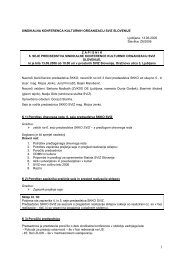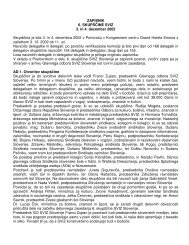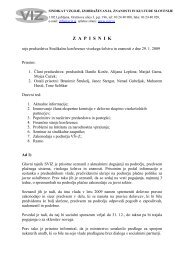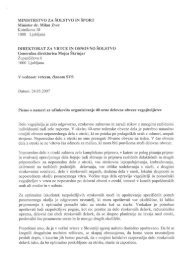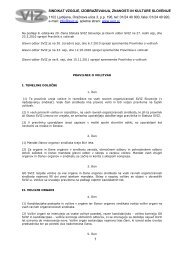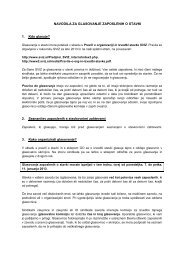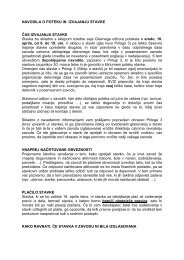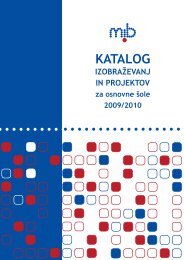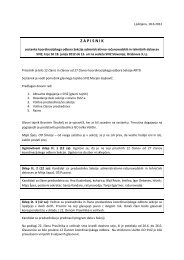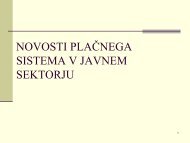You also want an ePaper? Increase the reach of your titles
YUMPU automatically turns print PDFs into web optimized ePapers that Google loves.
stavek je prvemu podoben po uporabi istih tonov, po ritmu, tempu in<br />
harmonizaciji pa se od njega razlikuje. Njegov pesemski značaj teži k<br />
variacijski obliki, a tudi oblikovno spominja na prvi stavek. Hitri menuet<br />
je le še reminiscenca na starinski ples, medtem ko se trio bliža dunajskemu<br />
ländlerju. Živahni finale v sonatni obliki je tehtna in velika sinteza<br />
dunajske klasike z elementi ljudske in plesne glasbe.<br />
Haydn je v »londonskih simfonijah« združil simfonične ideale 18. stoletja<br />
ter v njih zajel raznolikost glasbenih slogov in žanrov svojega časa.<br />
Simfonijo klasicizma je pripeljal do skrajnosti in zaključil bogato obdobje<br />
glasbene zgodovine. Simfonija št. 104 ima celo nekaj »mozartovskih«<br />
potez, s katerimi se je morda poklonil svojemu sopotniku v nekem glasbenem<br />
obdobju. Ko je Haydn pod zadnjo simfonijo napisal »Fine Laus<br />
Deo« (»Konec, Bogu hvala«), je morda slutil, da do konca življenja ne bo<br />
napisal nobene simfonije več. Kar je v njih iskal, je našel, in kar je hotel<br />
povedati, je tudi povedal.<br />
Sergei Prokofiev is known primarily for his symphonic works, such as the<br />
Classical Symphony and the musical fairy tale Peter and the Wolf. Artistically<br />
he stands between Stravinsky and Shostakovich, between the freedom of the<br />
cosmopolitan and the social realism of the Soviet Union. Although in his last<br />
years it seemed that he would have to choose between ‘patriotic ideals’, that<br />
is, the regime, and artistic freedom, he was fortunate in that after the war he<br />
created daring and original music that was at the same time ‘understandable’,<br />
as was demanded by the authorities.<br />
Prokofiev did not write a great number of chamber works; apart from two<br />
shorter compositions there is the sonata for violin, cello or flute and piano,<br />
the solo violin sonata and two string quartets. The Flute Sonata was written<br />
during the Second World War. Prokofiev responded to the events of the war<br />
with patriotic propaganda music, while also withdrawing into the ‘absolutism’<br />
and intimacy of instrumental, chamber music. The Flute Sonata falls into<br />
the period of this wave of chamber music creativity. It was first performed<br />
on 7 December 1943 in Moscow (in 1944 it was performed in its version for<br />
violin as the Violin Sonata No. 2). Counting amongst Prokofiev’s neoclassical<br />
works in terms of form, Sonata Op. 94 is joyous, clear and transparent. In the<br />
composition’s four movements the elegant working of the thematic material<br />
unfolds before the listener, full of fantasy and at the same time making exhaustive<br />
use of the colouristic and technical capabilities of the solo instrument.<br />
PROGRAM / PROGRAM<br />
Mozart’s quartets for transverse flute and strings are lighter occasional<br />
works. Three of them were written in Mannheim in the 1777/78 season for<br />
Ferdinand Dejean from the Dutch East India Company. Dejean had actually<br />
commissioned three concertos and three quartets with flute, but due to time<br />
pressure Mozart was unable to fulfil the commission entirely. At the time, the<br />
22-year-old composer was drawn more to the freedom that he experienced for<br />
75




